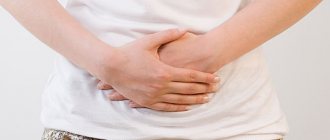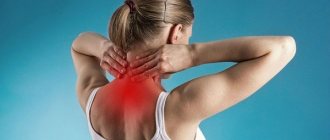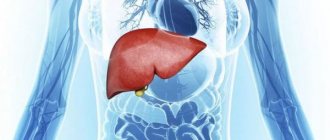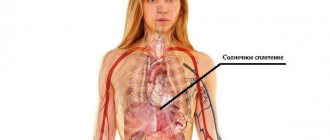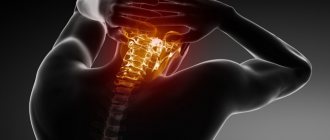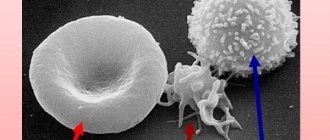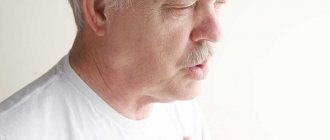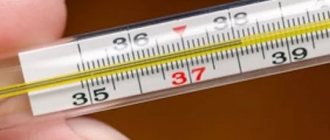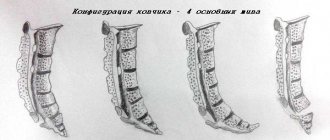Reasons for appearance
There are physiological and pathological causes of chest pain.
The main factors that are not diseases are the following:
- Staying in an uncomfortable position for a long time.
- Muscle spasm.
- Nervous disorders.
- Deficiency of vitamins and minerals, especially B vitamins.
- Prolonged and heavy physical activity.
- Regular overwork.
- Poisoning by the breakdown products of ethyl alcohol.
- Regular overeating, which causes stomach distension.
- Abuse of alcoholic beverages and cigarettes on a regular basis.
Other causes may also predispose to the development of the disease. In addition, bruises and other injuries to the chest and spinal column often provoke pain.
First aid for chest pain
Sharp pain in the middle of the chest can lead to painful shock and loss of consciousness. The patient's pulse quickens, the skin of the face and lips turns pale, confusion or fear appears in the eyes.
- What to doif there is pain between the chest and spine:
- Call an ambulance immediately.
- Place the patient in bed and elevate his legs slightly.
- Remove clothing that is constricting the neck and give a Nitroglycerin tablet. This drug has a vasodilating effect and normalizes the patient's condition.
- All unnecessary people should be removed from the room, since their presence will only irritate the patient.
- If the patient loses consciousness, it is necessary to give him a sniff of ammonia.
- You can use a reflex technique: squeeze the little finger on your left hand in the nail area until painful sensations appear, then release. Repeat this 5-6 times.
- What you should never doif your chest hurts when pressed:
- leave the patient alone;
- postpone calling an ambulance if the pain does not go away after taking appropriate medications;
- set bone fragments in case of injury;
- apply warm compresses until the cause of the pain is determined. For neuralgia, the compress helps, but for stomach ulcers it can be harmful.
Possible diseases
Pain in the middle of the sternum is most often provoked by any diseases of the internal organs. Moreover, the intensity, duration of discomfort, and accompanying symptoms depend on the type of pathology.
- Osteochondrosis thoracic spinal column – pathology of the intervertebral discs, in which their gradual destruction and displacement of the vertebrae occurs, followed by pinching of the nerve endings. Many patients mistake chest pain for a sign of heart disease. However, additional manifestations help differentiate the condition. Typically, patients experience numbness in the arms, pain in the mid-back, and spasm of the muscles of the spinal column.
- Bronchitis in the acute stage can cause discomfort. In this case, the patient usually has an elevated body temperature, cough and other symptoms. The pain appears after a long cough and disappears after a short period of time.
- Severe pneumonia This is especially common when a significant part of the lung is affected. In this case, all the symptoms of the disease are present in the form of cough, sputum and a significant increase in body temperature.
- Neuralgia developing against the background of osteochondrosis or after injury to the spinal column. Pathology can also be the result of insufficient intake of B vitamins into the body. In this case, the pain is localized in the middle, intensifies with inhalation and is not relieved by taking Nitroglycerin or other emergency medications. Usually after some time the pain disappears, but in most cases the patient needs to take a deep breath and change body position.
- Angina pectoris is one of the common heart diseases, characterized by periodic attacks. They are characterized by suffocation, severe pain in the sternum, fear of death and other manifestations. In this case, discomfort can be localized only in the heart area or radiate to the left arm, shoulder, or shoulder blade. When taking medications, the pain becomes less pronounced.
- Myocardial infarction is a pathology of the human heart muscle, which in most cases develops acutely and provokes pronounced manifestations. Pain in the sternum is considered the main symptom. However, it almost always radiates to the arm or shoulder, and the patient becomes pale. Other symptoms include severe weakness, increased activity of the sweat glands, and fear of death.
- Heart failure is a chronic heart disease in which pain appears only during an exacerbation. In this case, the patient is concerned about accompanying symptoms such as swelling of the extremities, increased or decreased blood pressure, and heart rhythm disturbances. It is worth noting that with heart failure, the pain does not extend to the shoulder or arm.
- Acute gastric ulcer or gastritis – one of the common causes of chest pain. It manifests itself especially acutely when a large ulcer forms on the walls and internal bleeding opens, as well as when the wall of an organ is perforated. Discomfort intensifies as the course of the underlying disease worsens, and symptoms from the digestive system appear.
- Coronary heart disease is a heart pathology that develops when there is insufficient oxygen supply to the myocardium. In this case, pain is a sign of heart rhythm disturbances and worsening of the condition. It is localized only in the middle, but sometimes it can radiate to the arm or collarbone area.
When it hurts on the left side
The following diseases can cause pain in the left side of the chest:
- Pancreatitis. The disease is characterized by inflammation of the pancreas, accompanied by pain in the left side of the chest, aggravated by eating. The patient sometimes has difficulty breathing.
- Spinal disease.
- Hernia in the area of the esophageal opening of the diaphragm. The cause of the disease is prolapse of the intestines into the chest cavity, and a characteristic symptom is heavy breathing after eating.
- Aortic aneurysm. The disease is characterized by dilation of the aorta, which can be detected by X-ray examination of the vessels.
- Stomach ulcer. The main sign indicating the presence of this disease is a feeling of chest tightness after eating. Pain syndrome is relieved with antispasmodics.
- Pericarditis. The pain manifests itself as a burning sensation in the chest area, and during inhalation the pain intensifies. The disease occurs due to inflammatory damage to the serous membrane of the heart.
- Angina pectoris. The onset of pain is characterized by suddenness. The pain that appears spreads to the entire left region of the chest. Sometimes the pain syndrome can spread to the kidney area or under the shoulder blade and even to the lower jaw. During an attack of angina, the patient develops a feeling of anxiety, and sometimes, on the contrary, depression. Some experience mental stress. The reason may lie in physical or emotional exhaustion. Listed above are the most common causes of pain in the left side of the chest. The full medical list is not limited to them.
Diagnostics
Pain in the middle of the sternum can be a sign of a serious illness, so it is better to visit a doctor who, using several effective methods, will identify the cause of the disorder and prescribe appropriate treatment.
| Method | Description | Venue and price |
| Questioning and general examination | The first stage in diagnosis, which allows us to identify the conditions for the appearance and disappearance of pain, as well as accompanying symptoms. The specialist not only listens to complaints, but also examines the patient, listens to the lungs, bronchi and heart, and measures blood pressure | Carried out in a public clinic free of charge |
| Clinical and biochemical blood test | A mandatory diagnostic method that involves taking blood from a vein and testing it in a laboratory. The method allows you to detect signs of inflammation in the body, and biochemical diagnostics additionally helps to identify pathologies of the heart and blood | The examination can be done at any clinic. In private the price is approximately 500 rubles. |
| ECG | Another mandatory examination method. Allows you to detect signs of heart attack, angina and coronary heart disease | Usually performed in a public clinic and does not require payment |
| X-ray of the spinal column | One of the important diagnostic methods in which the thoracic spine is examined. Usually the method is used when osteochondrosis is suspected | It is carried out in clinics equipped with special equipment and costs approximately 300-400 rubles. |
| Ultrasound | Hardware diagnostics that examine the heart, as well as the organs of the digestive system. The method is effective and helps to detect abnormalities in the functioning of organs | The examination is carried out in private offices or clinics, the price is approximately 800 rubles. |
| FGDS | Fibrogastroduodoscopy is a study in which a probe with a camera is inserted into the patient’s stomach and the mucous membranes are examined. Diagnostics used for suspected peptic ulcer or gastritis | It is carried out in a state clinic and costs approximately 300 rubles. |
| MRI | The most effective method to identify any abnormalities in internal organs. When diagnosing, special attention is paid to the heart, digestive organs and spinal column | Such an examination can only be performed in a clinic that has the appropriate equipment. |
Magnetic resonance imaging and ECG are considered the most effective and informative methods. Thanks to comprehensive diagnostics, it is possible to identify the cause of the deviation and prescribe appropriate treatment.
What to do if your sternum hurts in the middle
The appearance of discomfort in the middle of the chest requires urgent diagnosis. Basic methods:
- fluorography;
- ultrasonography;
- electrocardiogram;
- radiography;
- gastroscopy.
Treatment tactics are complex. The main stage is the elimination of pain. Drug groups:
- pathologies of blood vessels, heart - potassium and magnesium (Asparkam), cardiac (Nitroglycerin), glycosides (Celanide);
- respiratory organs - antiviral agents for infection (Tsiprolet, Metronidazole), anti-inflammatory (Nise, Ibuprofen), expectorants (Ascoril, Codelac broncho);
- gastrointestinal diseases - drugs to facilitate the passage of food (Ganaton), antiemetics (Motilium), proton pump blockers (Omez);
- problems with the spine - anti-inflammatory drugs (Diclofenac, Nimesulide), injections of painkillers for intercostal neuralgia.
Prevention
Pain in the sternum is quite difficult to prevent, since it can occur in a healthy person and against the background of any diseases. If the discomfort is localized in the middle, it is recommended to pay attention to nutrition and lifestyle.
You should regularly pay attention to sports, take walks or ride a bike, and attend group classes. This will keep the myocardium in good shape and prevent heart pathologies. You shouldn't overload your body, but regular exercise will be beneficial.
Additionally, it is necessary to enrich the diet with lean meat, fresh herbs and vegetables. This will allow you to get enough vitamins and minerals for normal heart function. It is also important to consume enough calcium-fortified dairy products. You should pay attention to your daily routine, devote more time to rest, and normalize night sleep.
Patients prone to heart disease are recommended to undergo regular examinations to identify pathologies at an early stage. The most important method of preventing complications is timely consultation with a doctor when the first symptoms of the disease appear.
Shots
Periodic, short-term tingling extremely rarely accompanies cardiovascular diseases. The approximate frequency is 20-25%. If there is a connection with cardiac pathologies, then they talk about the following conditions:
- Prolapse, stenosis or fusion of the mitral valve. This anatomical structure closes the gap between the left atrium and the ventricle, preventing blood from flowing in the opposite direction. With developmental defects, regurgitation of the MV occurs - a reverse flow of liquid connective tissue.
As a result, the contractility of the myocardium decreases, dilatation (stretching) of the chambers is formed, and the amount of blood ejected into the systemic circle is significantly reduced. Gradually, the process leads to disturbances in the anatomical development of cardiac structures.
Recovery involves early surgery. The sooner it is carried out, the higher the chances of a complete cure.
Episodes of pain are short. Often patients do not pay attention to this manifestation at all.
- Aortic valve stenosis. This structure is located at the level of the transition of the left ventricle into the main artery of the body. The role is identical: the movement of liquid connective tissue strictly in one direction. In a big circle.
Treatment is also surgical. Intense stabbing pain in the sternum is uncharacteristic, since the basis of the symptomatic complex is made up of other manifestations: shortness of breath, weakness, a drop or increase in blood pressure, and others.
- Aortic aneurysm in the development stage. It is a special formation, a wall protrusion of the artery. At the stage of formation, the pathological process makes itself felt with minimal discomfort.
Often there are no unpleasant sensations at all; the diagnosis is made on the basis of an objective assessment of the condition of the blood vessels. Surgical restoration involves excision of the changed area, but with great care.
- Neurosis of the heart with cardialgia. Why exactly heart pain occurs is not completely clear. It is assumed that we are talking about the work of the central nervous system, insufficient braking speed.
The development of discomfort is directly caused by stress and mental overload. Typically, a symptomatic complex appears in patients with a special personality type: vulnerability, impressionability, emotional lability as components.
A typical feature of pain of neurotic origin is the absence of evidence of organic pathology. Objective diagnostics show no abnormalities.
No special treatment is required. Despite this, the intensity of the shooting turns out to be significant. Hypochondriacal patients may falsely mistake an episode of neuralgia for a heart attack.
- Vegetative-vascular dystonia. It is a nonspecific syndrome. Develops as a result of diseases of the brain, hypothalamus, and endocrine system.
Contrary to the beliefs of a large part of the population and even the medical community, this is not a diagnosis, but a manifestation of a certain condition. The underlying disease needs to be treated, but not the symptom.
The restoration is carried out under the supervision of a group of specialists. Heart pain is relatively short in duration and does not pose a real threat to life.
- Myocarditis. Or inflammation of the muscle layer of the heart. It is an infectious (viral, bacterial, fungal), less often an autoimmune process. Requires urgent treatment in a hospital. The phenomenon quickly leads to tissue destruction. This is a direct indication for prosthetics.
In rare cases, the pathological manifestation is caused by a change in the innervation of the heart.
Stitching pain almost never indicates cardiac problems. The probability is 20% or so.
The cardiac nature of the manifestation should not be completely ruled out. If there are complaints, it is recommended to urgently carry out a diagnosis using ECHO, ECG and at least measure blood pressure and heart rate.
Treatment methods
Depending on the disease causing the pain, treatment is prescribed. Medicines are used, as well as folk remedies and alternative therapies.
Medications
Pain in the sternum in the middle will help eliminate medications from different groups, which are selected depending on the underlying disease.
The most effective means:
- Nitroglycerin is the most popular drug prescribed for an attack of heart disease. Helps normalize the functioning of the organ and eliminate heaviness and pain in the sternum. When a symptom appears, you should place 1 tablet of the product under your tongue. If there is no effect, re-taking the medicine is allowed after 40 minutes. The drug is not used for course treatment. Cost – from 50 rub.
- Barboval is a drug in the form of drops used for chest pain caused by angina pectoris or other heart pathology. If discomfort occurs, you must take 25 drops of the medicine; you can repeat it 2 times a day for 7-10 days. The product has sedative properties and eliminates pain. Price – from 120 rub.
- Validol is the most popular medication used for chest pain, as well as heart rhythm disturbances and tachycardia. Helps quickly eliminate manifestations, is not used in courses. If pain occurs, place 1 tablet under the tongue and repeat after 2 hours if necessary. The cost of the medicine starts from 20 rubles. for 10 tablets.
- Atenolol is a drug from the group of beta-blockers, which is prescribed to eliminate chest pain caused by heart disease. The medication reduces the heart rate by reducing the myocardium's need for oxygen, which reduces the load on the muscle and slightly reduces blood pressure. It is necessary to take the tablets in courses of 2-3 weeks. The patient should take 1 tablet in the morning and evening. The price of the product is approximately 80 rubles.
- Spasmalgon is an antispasmodic drug used for pain caused by muscle spasms or intercostal neuralgia, osteochondrosis. The patient is prescribed tablets, which he must take 2 pieces per day. The duration of the course should not exceed 10 days. The price of the drug starts from 60 rubles.
- Rennie is a remedy for reducing the acidity of gastric juice, which is used when pain is associated with exacerbation of gastritis or peptic ulcer. Helps quickly eliminate heartburn and discomfort, improves organ function. The patient is prescribed chewable tablets, which he takes 1 piece 3-4 times a day for 3-5 days. Price – from 150 rub.
- Omez is a medicine that blocks the production of hydrochloric acid and protects the walls of the stomach from its negative effects. The patient is recommended to take it in case of pain in the sternum associated with stomach pathologies. The course lasts 3 weeks, you should take 1 tablet 3 times a day. The price of the product is from 100 rubles.
- Ketorol is a non-steroidal anti-inflammatory drug with analgesic properties. Helps eliminate pain caused by osteochondrosis and additionally eliminates discomfort in the thoracic spine. You are allowed to take the tablets for no longer than 7 days in a row, 2 tablets per day. The cost of the medicine is approximately 130 rubles.
The patient may be prescribed one or more drugs depending on the severity of the underlying disease.
Traditional methods
Pain in the sternum in the middle can be eliminated with the help of alternative medicine recipes that have sedative properties. Typically, recipes are used when pathologies of the heart and digestive organs are suspected.
- Hawthorn decoction is the best remedy for strengthening the heart muscle and eliminating pain in the sternum. For 2 liters of water you need to take 200 g of pre-crushed hawthorn fruits, cook for 10 minutes, leave for at least 4 hours. Take 150 ml of the prepared and filtered medicine 2 times a day. The course lasts 2 weeks.
- A tincture based on valerian rhizome is also considered a good remedy. It can be obtained by infusing 20 g of pre-crushed rhizome in 100 ml of alcohol for 2 weeks. Take the finished medicine 20 drops in the morning and evening for 10 days.
- Rosehip decoction helps remove excess fluid from the body and reduce the load on the myocardium. It should be prepared from 100 g of crushed fruits and 1 liter of water. Cook for 5-7 minutes, leave for 30 minutes. Divide the filtered mixture into 3 equal parts and consume throughout the day. Repeat the procedure for at least 2 weeks.
Alternative medicine recipes can be used only in the absence of contraindications, and after consulting a doctor.
Other methods
Alternative treatment methods include diet therapy and relaxation therapy. These methods have a beneficial effect on the entire body, improve well-being, ease the work of the heart and reduce the frequency of symptoms. The main advantage of the methods is that they are effective for pain of any origin.
Diet therapy involves excluding the following products from the menu:
- Canned food.
- Marinades.
- Smoked meats.
- Confectionery.
- Fat meat.
- Fatty dairy products.
- Alcoholic drinks.
- Carbonated drinks.
- Fast food.
In addition, you should not abuse caffeinated drinks. The diet should consist of a small amount of boiled or stewed meat, fish, fresh and stewed vegetables. It is useful to include porridge, boiled potatoes, and greens. Among dairy products, preference should be given to those that contain a minimal amount of fat. It is recommended to adhere to this diet constantly.
Relaxation therapy involves daily relaxation using suitable music. After a difficult day, the patient is recommended to take a comfortable position, turn on the sounds of nature and breathe deeply for 20-30 minutes, feel how the tension leaves the body and the brain is freed.
After 2-3 sessions, relaxation will come faster, and your overall well-being will improve significantly. The minimum course consists of 20 daily sessions, but it is better to use the technique constantly.
Causes of pain in the center of the sternum in women
Median chest pain syndrome is caused by emotional experiences and frequent stress in women. Common reasons:
- mastopathy - soreness of the mammary gland with irradiation into the sternum due to compression of the nerve receptors;
- diseases of the thyroid gland (nodular goiter, hyperthyroidism) - intermittent aching pain, accompanied by pressure changes, a lump in the throat;
- excess weight – excessive load on the spine causes pain when walking and physical activity;
- wearing uncomfortable underwear - a tight bra puts pressure on the nerve endings, causing pain in the middle of the chest area;
- bad habits (smoking) – cause the development of chronic bronchitis;
- mastalgia - pain, swelling of the glands appear 3-5 days before the start of the menstrual cycle;
- breast cancer - manifests itself in the later stages with a burning sensation around the mammary gland, reflected pain in the middle of the sternum.
Possible complications
Without treatment, patients may develop complications. The most common is myocardial infarction. In addition, the development of cardiac and respiratory failure and coronary disease is possible.
Pain in the middle of the sternum may be a symptom of a heart attack!
In many patients, the course of osteochondrosis worsens, which provokes pain. In this case, the symptom is present almost constantly, and the pain in the spine intensifies. The most dangerous complication is considered to be death, which develops as a result of necrosis of a large area of the myocardium. Sometimes patients suffer a heart attack and do not see a doctor, which leads to dire consequences.
Chest pain can occur in patients of different genders and ages. Its localization in the middle indicates the development of a serious disease, so you should not put off visiting a doctor.
Article design: Vladimir the Great
What to do
When your chest tightens, you should do the following:
- Call an ambulance, as some causes of the disease are life-threatening.
- Take a sitting position and try to relax.
- For stable angina, take a nitroglycerin tablet under the tongue.
- Try to breathe calmly and evenly.
Thus, there are many etiological factors why the chest is bursting in the middle, right and left. Only a doctor can determine the immediate cause of the disease. Do not treat yourself - it is life-threatening!
Autonomic dysfunction
Pain may occur due to autonomic dysfunction of the central nervous system. Moreover, disorders of this kind are more common in children and adolescents.
The reasons for the development of such pathologies are:
- psycho-emotional factors;
- lesions of the central nervous system that occurred in the perinatal period;
- heredity.
Signs of autonomic dysfunction are:
- paroxysmal pain in the chest, squeezing or pressing in nature;
- accelerated heartbeat;
- feeling of lack of air;
- panic state;
- changes in pressure, with differences from low to high numbers, and vice versa;
- decrease in body temperature;
- gastrointestinal disorders;
- dizziness;
- insomnia;
- lethargy;
- depressive moods.
As a rule, the examination does not reveal serious physical abnormalities in the patient. Attacks of pain occur periodically, decreasing and increasing, lasting from 5-10 minutes to several days. And they arise after a person is very worried or has suffered severe physical stress.
To stop an attack, you need to take a sedative (tincture of motherwort, valerian or Validol).
How to make a distinction
Discomfort of cardiac origin has a number of distinctive features:
- Localized strictly in the center. There may be a slight shift to the left side, closer to the shoulder.
- It radiates to the shoulder blade, arm down to the hand, and cervical spine.
- The nature of the unpleasant sensation, as already mentioned, is pressure, burning, tingling (extremely rare).
- When changing body position or breathing, the intensity of the pain does not change. This indicates a lack of connection with the musculoskeletal system and the lungs. Most likely it is the heart that is to blame. At the same time, walking and especially intense physical activity will lead to increased discomfort.
- It can be relieved with Nitroglycerin (1 tablet). This is a typical feature of cardiac pain. But with a heart attack, the effect may be incomplete.
- Pressing on the back or chest does not change the strength of the discomfort.
- At rest, the pain syndrome decreases.
Attention:
These points are not considered reliable diagnostic criteria. There is a great deal of subjectivity, but at the same time, there are exceptions to every rule.
If discomfort develops in the chest, if it lasts more than 10-20 minutes, it is recommended to call an ambulance to resolve the issue of transportation to the hospital.
Psychological diseases due to stress
Pain in the middle of the chest, which is accompanied by a deterioration in mood, the appearance of depressive thoughts and an increase in anxiety, can be the consequences of stressful situations.
People who are suspicious and acutely sensitive to any conflict situations are susceptible to the occurrence of such pain. If the pain is accompanied by a panic attack, causing a person to become very nervous, out of breath and suffer from pressure changes and an increase in heart rate, then we are talking about autonomic disorders of the nervous system.
To get rid of such manifestations, it makes sense to seek support from a psychologist or psychotherapist, who will help cope with the experiences that worry a person, teach self-soothing and the principles of meditation.
Mediastinitis
An inflammatory disease of a microbial nature that affects the tissue of the mediastinum. The course of the pathology is acute or chronic. The pain primarily exerts pressure in the chest and often resembles an ischemic attack. Leaving the disease untreated is strictly prohibited.
© shutterstock
When this pathology is acute, in addition to pressing pain in the chest, the patient also experiences the following symptoms: chills, fever, tachycardia, severe intoxication of the body. With the chronic nature of the disease, only symptoms of compression of the chest organs often appear. In addition to the patient's chest pressure, there is usually a cough, shortness of breath, heart rhythm disturbances and complete exercise intolerance.
The disease is treated with antibiotics and, if necessary, surgery. What treatment is required in a particular case is determined by the attending physician, depending on the pathology causing the chest pressure and the patient’s condition.
Nature and localization of pain
As a rule, pain in the lower chest is associated with pathologies of the solar plexus
The main causes of pain under the chest in the middle below the solar plexus are conventionally divided into two large groups:
- Associated with dysfunction and development of pathologies of the central nervous system, as well as solar plexus nodes - the harmful effects of pathogenic microorganisms and infections, neuralgia and neuritis, developing against the background of tissue injury.
- Associated with dysfunction and pathologies of other internal organs and systems, often located far from the plexus itself.
Pain in the lower chest can have a different character, for example, pulling and aching or, conversely, strong, sharp and acute. Unpleasant sensations can bother you periodically or constantly.
Chest pain during exercise is not pathological
Often the cause of acute and sharp pain in the solar plexus area is severe physical fatigue and/or excessive physical exertion.
Such pain is usually intense and can be burning or stabbing, forcing the person to slow down, stop and rest. Severe pain during training is not pathological and is not considered dangerous. It’s easy to stop them; just be at rest for a little while.
If the pain does not subside and bothers a person for a long time, there is a possibility of developing plexitis.
The solar plexus area is injured by a blow to the stomach
The solar plexus area is most often injured as a result of the following actions:
- A blow to the upper abdomen from a foreign object, such as a ball.
- A blow to the gut is most often diagnosed during sparring.
- When the upper abdominal cavity is excessively tightened by a belt or, for example, a safety rope.
In case of injury, the clinical picture is expressed quite clearly and has the following recognizable character:
- painful sensations in the upper abdomen that radiate to the central part of the chest, reminiscent of heart pain;
- breathing problems;
- Warmth and a burning sensation may be felt in the lower abdomen;
- there may be a pronounced urge to empty the bowel, nausea;
- the nature of the pain can be strong, sharp and burning.
In most cases, it is possible to alleviate the condition by tucking your knees to your chest and lying on your left side.
Plexitis is characterized by severe paroxysmal pain
Neuritis or plexitis is a pathological condition accompanied by inflammation of the nerves and nodes of the organ. The pathological condition is accompanied by the following specific symptoms:
- acute and severe pain that occurs in attacks, which are characterized by different frequency;
- the nature of the pain is predominantly stabbing and boring;
- localization - along the central line of the abdomen in the upper part, as the pathological condition develops it can spread throughout the entire abdominal cavity;
- often accompanied by a feeling of heat or burning in the lower abdomen, sometimes a bursting sensation.
Plexitis can develop against the background of unsuccessful surgery, as a result of the development of intestinal infections, and also due to excessive physical exertion. The condition is dangerous, so it is recommended to immediately seek advice from a medical institution.
Neuralgia is a pathological condition accompanied by irritation of the solar plexus nerves, which leads to painful sensations. As a rule, the disease develops against the background of “wakefulness” of intestinal parasites, trauma to the sternum and the development of intestinal infections. The clinical picture is similar to the manifestation of neuritis, so diagnosing the pathology is not always easy.
Solaritis is tissue irritation and inflammation of the solar node. This disease is considered the most dangerous of all that can affect the solar plexus. In most cases, it is a complication of untreated neuralgia and/or plexitis, and is divided into chronic and acute forms.
The condition is characterized by the following clinical picture:
- disruption of the digestive system: complete or partial lack of appetite, belching, heartburn and constipation;
- at normal body temperature a person experiences fever;
- boring, burning, sharp and severe pain in the solar plexus area;
- heaviness in the abdominal area, bloating;
- pressing dull pain in the sternum.
Possible localization of pain due to problems in the chest
The sternum is a flat, oblong-shaped bone at the front of the chest. The ribs are attached to it with the help of cartilage, the second ends of which extend to the spine. In the upper part, the sternum is connected to the clavicle, and in the lower part there is the xiphoid process - cartilage, which over time acquires a more dense structure and grows into the sternum. A large number of nerve clusters are concentrated in it.
Typically, pain in the chest in the middle or on the side when pressed has a different nature and localization: behind the sternum, inside or when pressing on the chest. If discomfort is noted behind the sternum, or pain radiates to the sternum, such signs suggest a disease of the organ inside the chest or below the ribs, because
pain is transmitted through the spinal cord to the GC. If pain is noted in the sternum and is not accompanied by other constant signs, this indicates a pathology in the skeletal system of the sternum itself. If the patient has pain in the middle of the chest when pressed, there may be consequences of traumatic damage to the xiphoid process or the sternum itself, for example, a strong blow to this area and subsequent fracture.
It is necessary to identify the cause of chest pain based on the nature of the pain
Many people are familiar with chest pain. It can be a consequence of physical overexertion or a sign of a serious illness.
The chest contains vital organs. Their connection with the central nervous system occurs through the same nerve plexus. Therefore, pain impulses from different organs are perceived as pain in the chest. It may be of the following nature:
- sharp, pungent, burning;
- dull, aching;
- pressing, pulling.
The pain can also be paroxysmal, throbbing, constant or intermittent. It can occur when moving or at rest, pressing on the chest or coughing. Often painful sensations radiate to the shoulder blade, arm or back, radiating to the left or right from the center of the sternum.
Pulmonary embolism
The pathology, which also causes chest pain, is deadly and is characterized by blockage of a pulmonary artery by a blood clot. A blood clot forms, causing a blockage, most often in the veins of the legs or pelvis. The disorder is not an independent disease, but is defined as a complication of thrombosis of the leg veins. According to medical statistics, this phenomenon ranks third among the causes of sudden death. If medical care is provided in a timely manner, the number of deaths is 8%.
Ripple
It is detected during developing myocardial infarction or an attack of hypertension.
The first condition has already been described. As for hypertension, we usually talk about a significant increase in the tonometer reading. This is the so-called crisis state. Characterized by intensification and overload of cardiac activity.
The patient can only be removed from this situation in a hospital. The longer the experience of hypertension, the higher the risk of emergency.
Throbbing pain accompanies every heartbeat. Indicates insufficient efficiency in supplying the muscular organ itself with oxygen and nutrients.
Signs and reasons to call an ambulance
Among the signs that require a call to the emergency room:
- Discomfort that lasts more than 30 minutes. Regardless of the intensity. A heart attack is likely to develop. Better to play it safe.
- Severe, unbearable pain syndrome that is not relieved by Nitroglycerin.
- Dyspnea. Excluding even minimal physical activity. It occurs not only during dangerous events, but also during an attack of angina pectoris. Possible transformation into acute necrosis (infarction). There is no need to wait for the transition.
- Cephalgia (headache), dizziness. Moreover, if they are accompanied by the inability to navigate in space.
- Paralysis, paresis.
- Feeling of goosebumps running all over the body or in specific areas.
- Facial distortions. Inability to control facial muscles.
- Fainting, syncope. Especially repeated ones. Along with previous neurological symptoms, they indicate ischemia of cerebral structures and possible stroke.
- Speech is unclear. Fog in the field of vision, decreased hearing.
- Confusion.
- Paleness of the skin.
- Cyanosis of the nasolabial triangle.
These signs do not absolutely indicate that they are not a heart attack, stroke or other emergency conditions, but they are very common in them. This raises suspicions. Therefore, a thorough diagnosis is required in a short time.
Types of pain and possible diagnoses
It matters which side the irradiation occurs - left or right. Possible causes of pain:
- Entry of air or accumulation of blood inside the pleural cavity
- Pinched nerves
- Inflammation of the membranes of the heart, myocardial infarction
- Compression of the gallbladder by the developing fetus
- Abdominal and/or chest trauma
- Violation of joint integrity, osteochondrosis, osteoporosis
- Inflammation of the liver parenchyma
- Fractured ribs with or without respiratory damage
- Peptic ulcer, gastritis
The presence of a chronic focus of inflammation present in the body is also important.
Carrying out an examination, the specialist clarifies an important nuance for himself - what kind of pain the patient has, how he can describe it. The information obtained simplifies further diagnosis, since every competent doctor knows that different types of pain indicate the presence of certain diseases:
- Dull pain is a sign of injury (chest contusion, muscle strain), osteochondrosis of the thoracic spine, cracked ribs
- Pulling is a symptom of intercostal neuralgia, appears after physical exertion, a long stay in a stationary position, hypothermia
- Contracting - spasms indicate the presence of stomach pathology, impaired blood circulation after physical activity, osteochondrosis. Patients also sometimes perceive arrhythmia as a tugging, unpleasant sensation.
Despite the differences in the listed types of pain, they are united by the need to visit a specialist, conduct an examination, and possibly even undergo treatment.
It's a dull pain
The symptom of vague pain is characteristic of the course of gastric ulcer, inflammation of the intestinal mucosa. Additional symptoms are lack of appetite, nausea, bloating, diarrhea mixed with particles of undigested food. Discomfort in the abdomen appears in the morning, after eating. Aching pain under the breast is one of the signs of myocarditis. Especially if the appearance of an unpleasant sensation was preceded by physical activity.
Strong pain
Increased pain indicates the development of many pathologies, but most often they are:
- myocardial infarction
- arterial spasm
- emergency stomach or intestinal conditions
- aortic aneurysm
- pneumothorax
- pancreatitis
- metastases to the lungs directed by a malignant tumor present in the body
In this case, attention is drawn to a sharp decrease in blood pressure, pale skin, sweat on the face, and weakness. With a gastric ulcer, blood appears in the stool and vomit. With pancreatitis, attention is drawn to the girdling nature of the pain.
Metastases in the lungs are detected during radiation imaging methods. As in the pelvic bones, the brain, they can be directed to the respiratory organs by malignant tumor processes present in the body.
Sharp pain
Problems with the condition of the gallbladder can cause sharp pain; against the background of renal colic, patients also often experience an unpleasant sensation under the breast. This type of pain syndrome is characteristic of thromboembolism, an extremely dangerous pathological condition. In this case, characteristic signs are instant blueness of the skin of the face, the appearance of bleeding through the oral cavity, and loss of consciousness. This condition is known to be fatal and is therefore better prevented than treated.
Stitching pain
Pain under the breast with episodes of tingling in the right side is a sign of impaired functional activity of the liver. The development of the condition is promoted by overeating, consumption of fatty foods, bending of the gallbladder, cirrhosis, and cholelithiasis. If it is determined that the liver is in order, the cause should be sought in the condition of the diaphragm.
Pain under the shoulder blade
If the pain is not associated with a heart disorder, the sign indicates the presence of problems with the diaphragm and spine. When a hernia forms in the diaphragm, intense discomfort appears due to the upward displacement of the stomach. The diaphragm anatomically separates the thoracic cavity from the abdominal cavity. The pressure inside causes discomfort.
Pathologies of the spine manifest themselves as follows:
- the patient is bothered by a nagging or burning pain
- Changing position does not bring long-term relief
- the problem area of the body may be deformed - due to swelling or disintegration of the cartilage tissue of the vertebrae
- physical activity is limited
The listed violations are clearly displayed in the image taken during an x-ray examination.
Soreness of the mammary glands is a tissue reaction to hormonal changes. Normally, swelling and increased sensitivity of the female breast accompanies the period on the eve of menstruation, pregnancy, and the postpartum state. But in other cases, pain in the mammary glands indicates the presence of a disease. Its nature (benign or malignant) is determined by mammography. Alarming signs are breast deformation, changes in the color and structure of the nipple and areola.
When first aid is needed
In case of chest injuries, the patient must be placed in a semi-sitting position
Treatment depends on the cause of the pain and the complexity of the situation. Some conditions require emergency medical attention. It is important to know what to do in case of injuries, bruises and heart attacks.
In case of injury, before the arrival of the medical team, you must perform the following actions:
- give the victim a semi-sitting position;
- remove or loosen clothing that restricts breathing;
- if you faint, give them a whiff of cotton wool with ammonia;
- apply cold on top of the chest;
- Give the victim a painkiller tablet.
A patient with an acute heart attack should be placed with the upper body elevated high. Increase air flow in the room. Loosen the belt, tie, unfasten the buttons on the chest. Give a tablet of validol, nitroglycerin. To prevent blood clots, the patient can take aspirin. A person should not be left alone; his condition should be checked periodically.
